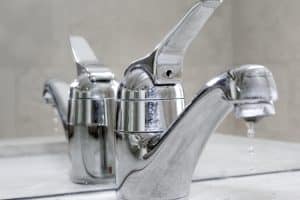Is the constant tap dripping water in your house stressing you out? Then you are not alone! This is a problem many people face in their homes or offices.
That never-ending drip that just won’t quit. It’s not just messing with your sanity, it’s wasting water too! And if you leave it, well, things could get worse. But hold on, no need to call in the plumber brigade just yet! With a little DIY magic and some basic tools, you can fix that leaky faucet yourself.
This guide will crack the code on your leaky friend and get it fixed in a flash. Save some cash, silence the annoying drip, and chill out with a faucet that finally behaves!
What’s causing your leaky faucet?
Fixing a leaky faucet yourself is totally doable, even if you’re not super handy. First things first, figure out why your faucet is on the fritz. Common culprits are worn-out washers (they get old and tired just like everyone else!), busted cartridges (the things that control the water flow), or seals that aren’t sealing properly anymore.
The key to tackling this drip is knowing what kind of faucet you have. Different faucets have different parts and require slightly different fixes. There are four main types: compression, cartridge, ball, and ceramic disc.
What essential tools and materials will you need to fix a dripping tap?
No sweat, fixing a leak can be done with a few things you probably already have! Not only will you get some peace back in your house, but you’ll also be contributing to water conservation efforts. Here’s what you’ll need:

- Adjustable wrench: For tightening loose nuts and fittings.
- Socket wrench set (optional): If your tap uses hex nuts, a socket wrench set might be necessary.
- Phillips head screwdriver: For removing tap handle screws.
- Flathead screwdriver (optional): For prying off decorative caps or handles.
- Needle-nose pliers (optional): For removing small parts or tight-fitting nuts.
- Replacement washers: Purchase washers specifically designed for your tap model. Most hardware stores carry a variety of washer sizes and types.
- Replacement cartridge (if applicable): If you suspect a defective cartridge, just peek at your faucet manual or the brand’s website to find the perfect replacement.
- Plumber’s tape (optional): For creating a tighter seal around threads during reassembly.
- Towel or rag: To catch any drips or spills during the repair process.
Step by step guide to fixing a dripping tap
Okay, so your washer’s acting up. Don’t worry, you can fix this! Most of the time, it’s just a tired-out washer that needs a little TLC. Here’s how to get your laundry mate back in fighting shape, and stop that annoying tap dripping water sound!
- Turn off the water: No need to drench the place, just grab a wet rag and wipe around the tap to make things clear.
- Handle time: Find the sneaky screw holding the handle on. Grab your Phillips screwdriver and loosen those screws, but be careful not to go ham on it! Some faucets might be shy and hide their screws under a little cap. You can pop that cap off with a flathead if you need to.
- Behold, the washer: Once the handle’s off, you’ll see a valve stem with a washer at the bottom where it meets the valve seat. This little washer is probably the culprit.
- Swap the washer (if needed): Grab some needle-nose pliers (carefully!) to take out the old washer. Take a good look at its size and shape so you can get the perfect replacement. Pop in the new tap washer and make sure it’s snug at the base of the valve stem.
- Put it back together: Basically, do the opposite of what you just did. Put the handle back on the screw thread, but don’t crank it too tight. Pro tip: wrap some thread tape around the threads before screwing the handle back on for a better seal.
- Water on: Slowly turn the shut-off valve to let the water flow back into the tap. Turn on the handle and see if it’s all good. If there’s a tiny drip, carefully tighten the handle screw a bit more.
And voila! You’ve successfully stopped dripping water from your tap and can finally enjoy the peace and quiet.
Beyond the washer: Addressing other leak sources

- Faulty cartridge: Still dripping after the washer swap? And your faucet uses a cartridge instead of a washer? No worries! Check the manufacturer’s website or manual for their specific removal instructions. It’s usually handle off, unscrew the old cartridge housing, pop in the new one, and put it all back together snugly.
- Loose tap handle: For a wobbly handle, or even a stuck tap handle, grab a wrench and tighten the packing nut under it. Just go slow and steady until the handle feels solid – don’t crank too hard or you might wreck the O-ring or nut.
- Damaged valve seat (less common): Valve seat issues are a bit rarer. If the washer replacement whiffed and you suspect a damaged valve seat, call in a plumber. Those can be trickier and often require fancy tools and know-how.
Conclusion
Fixing a leaky tap yourself is totally doable, even if it seems scary at first. Just grab the right tools, follow these steps, and say goodbye to that annoying drip-drip-drip under the sink. Plus, you’ll save some cash and feel like a DIY superhero! Of course, if things get too hairy, calling a plumber is always an option. The key is to be safe and get that leak stopped so you can enjoy a peaceful, leak-free home again!
When DIY isn’t enough: Call Apex Plumbing Services!
Faucet fight not going your way? Don’t sweat it! For guaranteed leak repair, contact Apex Plumbing Services! We’re always happy to help, so don’t hesitate to reach out if you run into any trouble or simply prefer a professional to handle the job. We’ll have your sink functioning smoothly again (no more dripping symphony!).


